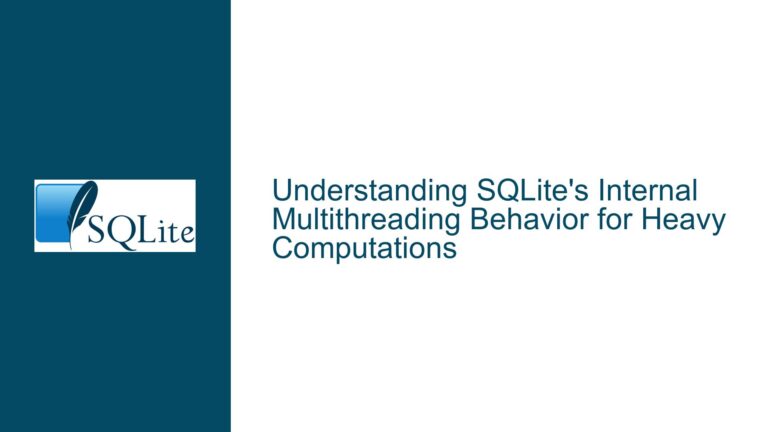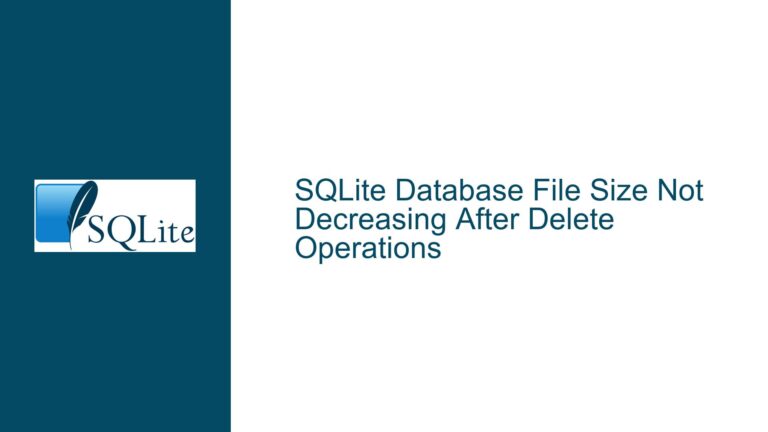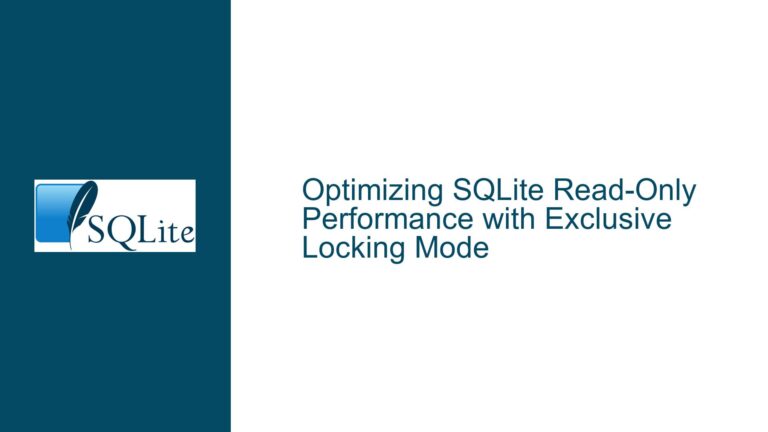Exfiltrating SQLite Queries with Query Plans and Runtime Statistics Using LD_PRELOAD
Exfiltrating SQLite Queries with Query Plans and Runtime Statistics
The core issue revolves around the ability to capture and analyze SQLite queries, including their query plans and runtime statistics, by leveraging a custom library injected via LD_PRELOAD. This technique allows for the interception of all database activity, including the SQL statements executed, their bound parameters, and the associated query execution details. The captured data is then processed and analyzed to identify performance bottlenecks, optimize queries, and reproduce issues in a controlled environment. This approach is particularly useful for debugging and performance tuning in applications that heavily rely on SQLite.
The library, named federprof, is designed to pipe the captured data in NDJSON (Newline Delimited JSON) format to a user-supplied command, enabling further processing and analysis. The data includes detailed information about the query execution, such as the number of virtual machine steps, the number of times a query was run, and the number of visits and cycles for each scan operation. This information is crucial for understanding the performance characteristics of the queries and identifying potential optimizations.
The captured data can be processed using tools like DuckDB, which allows for advanced querying and aggregation of the NDJSON data. For example, one can calculate the total number of virtual machine steps, the total number of runs, and the sum of visits and cycles for each query plan. This enables the identification of the most expensive queries in terms of execution time and resource usage.
Challenges in Capturing and Analyzing SQLite Query Execution Data
One of the primary challenges in capturing and analyzing SQLite query execution data is the need to intercept and record all database activity without significantly impacting the performance of the application. The LD_PRELOAD technique allows for the injection of the custom library into the process, but it must be done in a way that minimizes overhead and ensures that the captured data is accurate and complete.
Another challenge is the processing and analysis of the captured data. The NDJSON format is chosen for its simplicity and ease of use, but it requires additional tools and scripts to parse and analyze the data effectively. DuckDB is used in this case to process the NDJSON data, but other tools or custom scripts could also be used depending on the specific requirements and preferences.
The complexity of the query plans and runtime statistics also poses a challenge. The captured data includes detailed information about each scan operation, such as the index used, the parent operation, and the number of visits and cycles. This information must be carefully analyzed to understand the performance characteristics of the queries and identify potential optimizations.
Steps to Implement and Optimize Query Capture and Analysis
To implement and optimize the capture and analysis of SQLite query execution data, the following steps can be taken:
Inject the Custom Library Using LD_PRELOAD: The first step is to inject the custom library into the process using the
LD_PRELOADenvironment variable. This allows the library to intercept all calls to SQLite functions and capture the necessary data. The library should be designed to minimize overhead and ensure that the captured data is accurate and complete.Capture Query Execution Data: The custom library should capture all SQL statements executed, their bound parameters, and the associated query execution details. This includes the number of virtual machine steps, the number of times a query was run, and the number of visits and cycles for each scan operation. The captured data should be output in NDJSON format for further processing.
Process and Analyze the Captured Data: The captured NDJSON data can be processed and analyzed using tools like DuckDB. This allows for advanced querying and aggregation of the data, enabling the identification of the most expensive queries in terms of execution time and resource usage. Custom scripts or other tools can also be used depending on the specific requirements and preferences.
Optimize Queries Based on Analysis: Based on the analysis of the captured data, queries can be optimized to improve performance. This may involve rewriting queries, adding or modifying indexes, or making other changes to the database schema or application code. The goal is to reduce the number of virtual machine steps, runs, visits, and cycles for the most expensive queries, thereby improving overall performance.
Reproduce Issues in a Controlled Environment: The captured data can be used to reproduce issues in a controlled environment, allowing for more detailed analysis and debugging. This is particularly useful for identifying and fixing performance bottlenecks or other issues that are difficult to reproduce in a production environment.
Monitor and Continuously Improve: The process of capturing and analyzing SQLite query execution data should be ongoing. Regular monitoring and analysis can help identify new performance bottlenecks or other issues as they arise, allowing for continuous improvement of the application’s performance.
By following these steps, developers can effectively capture and analyze SQLite query execution data, identify performance bottlenecks, and optimize queries to improve overall application performance. The use of tools like DuckDB and the NDJSON format simplifies the processing and analysis of the captured data, making it easier to identify and address performance issues.
Detailed Explanation of the Query Execution Data
The query execution data captured by the custom library includes several key metrics that are crucial for understanding the performance characteristics of SQLite queries. These metrics include:
Virtual Machine Steps (vm_step): This metric represents the number of steps executed by the SQLite virtual machine for a given query. Each step corresponds to a low-level operation performed by the virtual machine, such as fetching a row from a table or performing a calculation. A high number of virtual machine steps indicates that the query is performing a large number of low-level operations, which can be a sign of inefficiency.
Number of Runs (run): This metric represents the number of times a query was executed. A high number of runs may indicate that the query is being executed repeatedly, which can be a sign of inefficiency or a potential optimization opportunity.
Number of Visits (nvisit): This metric represents the number of times a scan operation was visited during the execution of a query. Each visit corresponds to a row that was processed by the scan operation. A high number of visits indicates that the scan operation is processing a large number of rows, which can be a sign of inefficiency.
Number of Cycles (ncycle): This metric represents the number of cycles executed by the scan operation. Each cycle corresponds to a low-level operation performed by the scan operation, such as fetching a row from an index or performing a comparison. A high number of cycles indicates that the scan operation is performing a large number of low-level operations, which can be a sign of inefficiency.
Query Plan (plan): This metric represents the query plan used by SQLite to execute the query. The query plan includes information about the order in which tables are accessed, the indexes used, and the operations performed. The query plan is crucial for understanding how SQLite is executing the query and identifying potential optimizations.
Unexpanded SQL (unexpanded): This metric represents the original SQL statement before any expansion or transformation by SQLite. This can be useful for understanding the original intent of the query and identifying any discrepancies between the original SQL and the actual execution plan.
Analyzing Query Execution Data with DuckDB
DuckDB is a powerful tool for analyzing the captured query execution data. The following example demonstrates how to use DuckDB to process and analyze the NDJSON data:
drop macro if exists plan_md5;
create macro plan_md5(scanstatus) as
md5(
list_transform(
scanstatus,
x -> json_array(x.idx, x.selectid, x.parentid, x.name, x.explain)
)
);
select
sum(vm_step),
sum(run),
sum(list_aggregate(list_transform(scanstatus, x -> x.nvisit), 'sum')) as sum_nvisit,
sum(list_aggregate(list_transform(scanstatus, x -> x.ncycle), 'sum')) as sum_ncycle,
plan_md5(scanstatus) as plan,
unexpanded
from
read_ndjson_auto('logfile.gz')
group by
unexpanded,
plan
order by
4 desc nulls last;
In this example, the plan_md5 macro is used to calculate a hash of the query plan, which allows for grouping queries by their execution plan. The sum function is used to aggregate the virtual machine steps, runs, visits, and cycles for each query plan. The results are then ordered by the total number of cycles, allowing for the identification of the most expensive queries in terms of execution time and resource usage.
Optimizing Queries Based on Analysis
Once the most expensive queries have been identified, the next step is to optimize them. This may involve rewriting the queries, adding or modifying indexes, or making other changes to the database schema or application code. The goal is to reduce the number of virtual machine steps, runs, visits, and cycles for the most expensive queries, thereby improving overall performance.
For example, if a query is found to have a high number of visits and cycles, it may be possible to optimize it by adding an index on the columns used in the query’s WHERE clause. This can reduce the number of rows that need to be scanned, thereby reducing the number of visits and cycles.
Similarly, if a query is found to have a high number of virtual machine steps, it may be possible to optimize it by rewriting the query to reduce the number of low-level operations performed by the virtual machine. This can be achieved by simplifying the query, reducing the number of joins, or using more efficient SQL constructs.
Reproducing Issues in a Controlled Environment
The captured query execution data can also be used to reproduce issues in a controlled environment. This is particularly useful for identifying and fixing performance bottlenecks or other issues that are difficult to reproduce in a production environment.
For example, if a query is found to be slow in production, the captured data can be used to recreate the exact conditions under which the query was executed. This allows for more detailed analysis and debugging, and can help identify the root cause of the performance issue.
Continuous Monitoring and Improvement
Finally, the process of capturing and analyzing SQLite query execution data should be ongoing. Regular monitoring and analysis can help identify new performance bottlenecks or other issues as they arise, allowing for continuous improvement of the application’s performance.
By continuously monitoring and analyzing query execution data, developers can ensure that their applications remain performant and efficient, even as the workload and data volume grow over time. This proactive approach to performance tuning can help prevent issues before they become critical, and ensure that the application continues to meet the needs of its users.
Conclusion
Capturing and analyzing SQLite query execution data using a custom library injected via LD_PRELOAD is a powerful technique for identifying and optimizing performance bottlenecks. By leveraging tools like DuckDB and the NDJSON format, developers can gain deep insights into the performance characteristics of their queries and make informed decisions about how to optimize them. This approach not only improves the performance of individual queries but also enhances the overall efficiency and reliability of the application.






